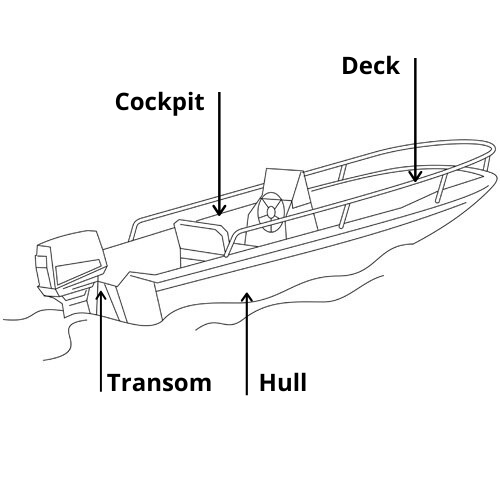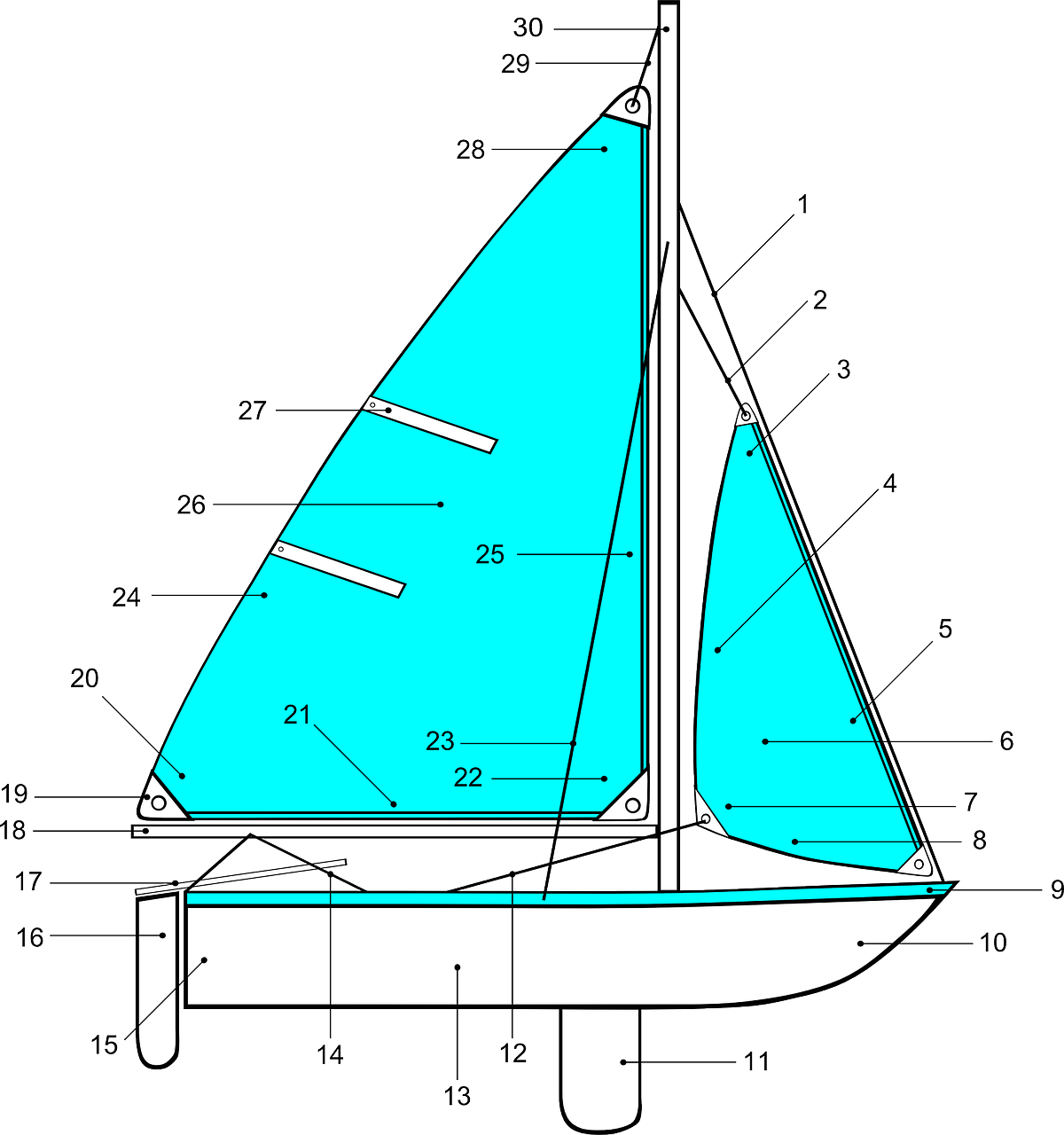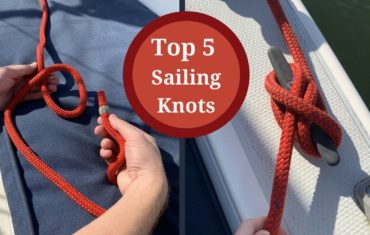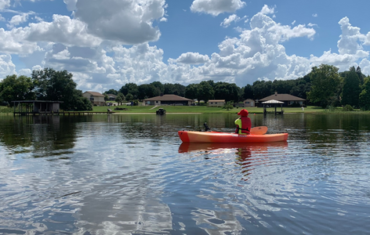Learning how to sail a boat, using only the wind as your “motor” – can be a liberating experience. For some, sailing is the ultimate sensation of freedom. It is the ability to travel on only the “fuel” of mother nature. For anyone interested in learning how to sail – this article is an introduction to the sport of sailing by learning the parts of a sailboat.
What Makes up a Typical Boat?
There are many different types of boats or watercraft. Whether you’re on a canoe or large sailing vessel, these main directional terms will apply.
- Bow: The front of the boat is known as the bow.
- Stern: The back is called the stern of the boat. Whether you’re on a 16 foot Canoe or a 50 foot sailboat, you steer a boat from its stern.
- Starboard: The right side of the boat when facing forward.
- Port: The left side of the boat when facing forward. A trick to remember starboard vs port is that “Port” is on the “Left” and both words have only 4 letters!

Other Basic Parts of a Typical Boat
Below are other terms used to describe basic parts that can be found on most watercraft.
- Hull: This is the bottom of the boat that sits in the water. The hull can be made of many different materials depending on the type of boat you’re looking at. Boats can have one hull, known as a “mono-hull”; or a “multi-hull” like a Catamaran.
- Deck: Located above the water, the top of the boat is often referred to as the “deck”.
- Cockpit: This is where the pilot of the boat or “helmsman” will steer the boat.
- Transom: Located at the stern, this is usually where a motor or auxiliary power source is located or where the rudder for steering (which we’ll cover later) is mounted.

What is a Keel?
Located under the boat is the keel. The purpose of the keel is to keep a sailboat from slipping sideways through the water when sailing towards the wind.
There are different variations of a keel on a sailboat.
- Fixed Keel: Permanent structure. Boats with a fixed keel are often more sturdy on the water but have to maintain diligent awareness of the depth of the water. In shallow water, if a keel hits the bottom (also known as running aground), it can be more difficult to get off the bottom than other keels.
- Centerboard: Large blade extending below the waterline, usually placed at the center of the vessel. Unlike a fixed keel, a centerboard can swing up and back inside of the hull.
- Dagger-board: Large blade that is lowered straight down from the cockpit.
What are the Parts of a Sailboat?
In addition to the basic boat parts listed above, a sailboat has a sailing rig and other parts that lay below the waterline. These parts work together with the wind to move the boat forward. There are different variations of sailing rigs. However many sailboats use what’s known as a sloop rig. Below are typical parts for a sloop rigged sailboat.

- Fore-stay: Wire or line connecting the mast to the bow.
- Halyard (Jib): Line used to raise and lower a sail. (Ropes on a sailboat are called “lines” or “sheets”)
- Head (Jib): Top corner of the sail that connects to the halyard which raises the sail.
- Leech (Jib): The edge of the sail between the head and clew also known as the trailing edge.
- Luff (Jib): The front edge of the sail between the head of the sail and tack.
- Head sail or Jib: Smaller sail located ahead or forward of the mainsail. It’s usually connected to the fore-stay. There are different types of head sails, but many boats use a sail called a jib.
- Clew (Jib): Back corner of the sail.
- Foot (Jib): Bottom edge of the sail that lays along the boom.
- Deck: Top surface of the boat.
- Bow: Front of the boat
- Keel: As described above, located under the hull.
- Jib Sheet: Line used to control the movement of the jib or head sail inward or away from the centerline of the sailboat.
- Hull: Bottom of the boat
- Main sheet: Line used to control the movement of the main sail inward or away from the centerline of the boat.
- Stern: Back of the boat.
- Rudder: Large blade connected to the rear of the vessel below the waterline, used to steer the boat.
- Tiller: Pole connected to the rudder used to control the rudder’s direction.
- Boom: Horizontal pole extending back from the mast.
- Out-haul: Line that connects to the corner (or “clew”) of the sail and pulls back to the rear of the boom
- Clew (Main): Back corner of the sail.
- Foot (Jib): Bottom edge of the sail that lays along the boom.
- Tack: The lower corner just below the head of the sail that attaches where the boom and mast meet. This corner is often marked with the logo of the sail manufacturer.
- Shrouds: Wires or lines connecting the mast to the deck on both the starboard and port sides.
- Leech (Main): The edge of the sail between the head and clew also known as the trailing edge.
- Luff (Main): The front edge of the sail between the head of the sail and tack that aligns with the Mast.
- Mainsail: The large, usually triangle shaped cloth or other material used to catch the wind. The mainsail will be “aft”, or behind, the mast.
- Batten: Long thin plastic strips that support the sail.
- Head (Main): Top corner of the sail that connects to the halyard which raises the sail.
- Halyard (Main): The line used to raise and lower the mainsail.
- Mast: Large, vertical pole extending up from the deck.
Other Terms Used on a Typical Sail Boat
Below are other terms used to describe typical parts found on a sailboat.
- Gooseneck: Where the boom attaches to the mast.
- Topping Lift: Holds the boom up when the sails are not yet hoisted. This is helpful in rigging the sails but is not available on all sailboats.
- Back-stay: Wire or line connecting the mast to the stern.
- Halyard: Line used to raise and lower a sail.
- Boom Vang: Lines that connect from the bottom of the boom to base of the mast which controls the shape of the sail. .
- Helm: Term used to describe the tiller/rudder combination. To “take the helm” is to take over steering the boat. Larger boats can have a traditional steering wheel at the helm instead of a tiller.
- Clet: A metal fixture located in various positions on the deck. These fixtures are used to tie lines for various reasons. The can be used to secure a boat to the dock, change sail position or attach fenders to the side.
While this article covers most of what you will find on a sailboat, they come in various shapes and sizes with various types of rigging and parts. In the next articles we will cover how to rig a sailboat followed by the basics of wind detection and how the direction of the wind maneuvers the boat.
Tell us in the comments if you have any specific questions about sailing you want us to cover in future articles!



